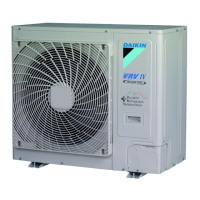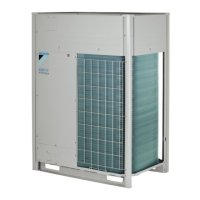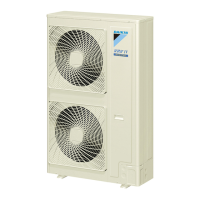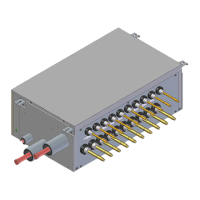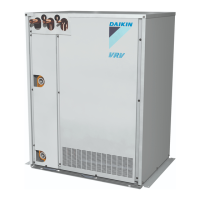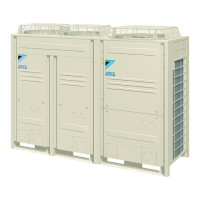8. Precautions on refrigerant piping
r Do not allow anything other than the designated refrigerant to get
OKZGFKPVQVJGTGHTKIGTCPVE[ENGUWEJCUCKTPKVTQIGPGVE+HCP[
refrigerant gas leaks while working on the unit, ventilate the room
thoroughly right away.
r Use R410A only when adding refrigerant
r Installation tools:
Make sure to use installation tools (gauge manifold, charge hose,
GVEVJCVCTGGZENWUKXGN[WUGFHQT4#KPUVCNNCVKQPUVQYKVJUVCPF
the pressure and to prevent foreign materials (e.g., mineral oils and
OQKUVWTGHTQOOKZKPIKPVQVJGU[UVGO
r Vacuum pump:
- Use a 2-stage vacuum pump with a non-return valve.
- /CMGUWTGVJGRWORQKNFQGUPQVƃQYQRRQUKVGN[KPVQVJGU[UVGO
while the pump is not working.
- Use a vacuum pump which can evacuate to 500 microns.
Protection against contamination when installing pipes
Take measures to prevent foreign materials like moisture and contami-
PCVKQPHTQOOKZKPIKPVQVJGU[UVGO
Installation Protection method
More than a month Pinch the pipe
Less than a month
Pinch or tape pipe
Regardless of the period
Block all gaps in the holes for passing out piping and wiring using seal-
KPIOCVGTKCNƂGNFUWRRN[VJGECRCEKV[QHVJGWPKVYKNNFTQRCPFUOCNN
animals may enter the machine).
Example: passing piping out through the front.
1
1
Close the areas marked with
.
(When the piping is routed from the
front panel.)
r Use clean pipes only.
r Hold the pipe end downwards when removing burrs.
r Cover the pipe end when inserting it through a wall so that no dust
or dirt enters the pipe.
NOTE
r After all the piping has been connected, make sure there is no gas
leak. Use Dry Nitrogen to perform a gas leak detection.
r After knocking out the holes, we recommend you remove burrs in
the knock holes and paint the edges and areas around the edges
using the repair paint.
8.1. Caution for brazing
r Make sure to blow through with Dry Nitrogen when brazing. Blowing
through with Dry Nitrogen prevents the creation of large quantities
QHQZKFK\GFƂNOQPVJGKPUKFGQHVJGRKRKPI#PQZKFK\GFƂNOCF-
versely affects valves and compressors in the refrigerating system
and prevents proper operation.
r The Dry Nitrogen pressure should be set to 2.9 psi (0.02 MPa (i.e.,
just enough so it can be felt on the skin)) with a pressure-reducing
valve.
6
6
1 Refrigerant piping
2 Part to be brazed
3 Taping
4 Hands valve
5 Pressure-reducing valve
6 Dry Nitrogen
&QPQVWUGCPVKQZKFCPVUYJGPDTC\KPIVJGRKRGLQKPVU4GUKFWGECP
clog pipes and break equipment:
r &QPQVWUGƃWZYJGPDTC\KPIEQRRGTVQEQRRGTTGHTKIGTCPVRKRKPI
7UGRJQURJQTEQRRGTDTC\KPIƂNNGTCNNQ[$%W2YJKEJFQGUPQV
TGSWKTGƃWZ
r (NWZJCUCPGZVTGOGN[JCTOHWNKPƃWGPEGQPTGHTKIGTCPVRKRKPI
U[UVGOU(QTKPUVCPEGKHEJNQTKPGDCUGFƃWZKUWUGFKVYKNNECWUG
RKRGEQTTQUKQPQTKPRCTVKEWNCTKHVJGƃWZEQPVCKPUƃWQTKPGKVYKNN
deteriorate the refrigerant oil.
8.2. Connecting the refrigerant piping
8.2.1. &GEKFGHTQPVQTUKFGDQVVQOEQPPGEVKQP
Installation of refrigerant piping is possible as front connection or side con-
PGEVKQPYJGPVCMGPQWVHTQOVJGDQVVQOCUUJQYPKPVJGƂIWTGDGNQY
12
3
1 Left-side connection
2 Front connection
3 Right-side connection
r For side connections, the knockout hole on the bottom plate should
be removed:
3
2
1
1 Large knockout hole
2 Drill
3 Points for drilling
NOTE
Precautions when knocking out knockout holes:
r Be sure to avoid damaging the casing.
r After knocking out the knockout holes, we recommend you remove
the burrs and paint the edges and areas around the edges using
repair paint to prevent rusting.
r When passing electrical wiring through the knock holes, protect the wir-
ing with a conduit or bushings, making sure not to damage the wiring.
8.2.2. Remove the pinched pipes
WARNING
Any gas or oil remaining inside the stop valve may blow off the pinched
piping.
Failure to observe the instructions in procedure below properly may
result in property damage or personal injury, which may be serious
depending on the circumstances.
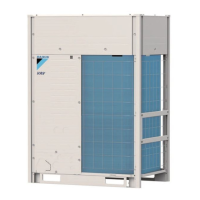
